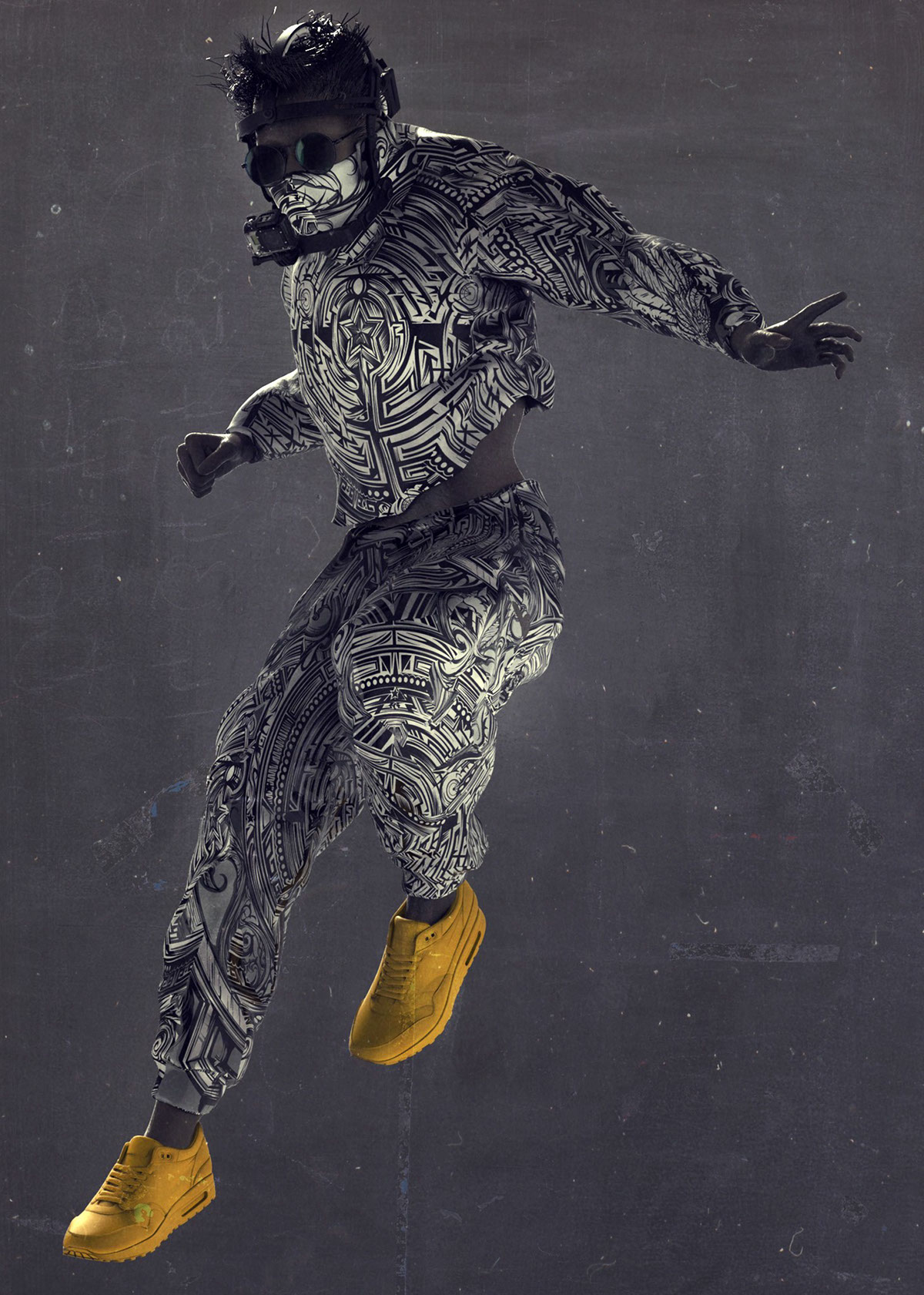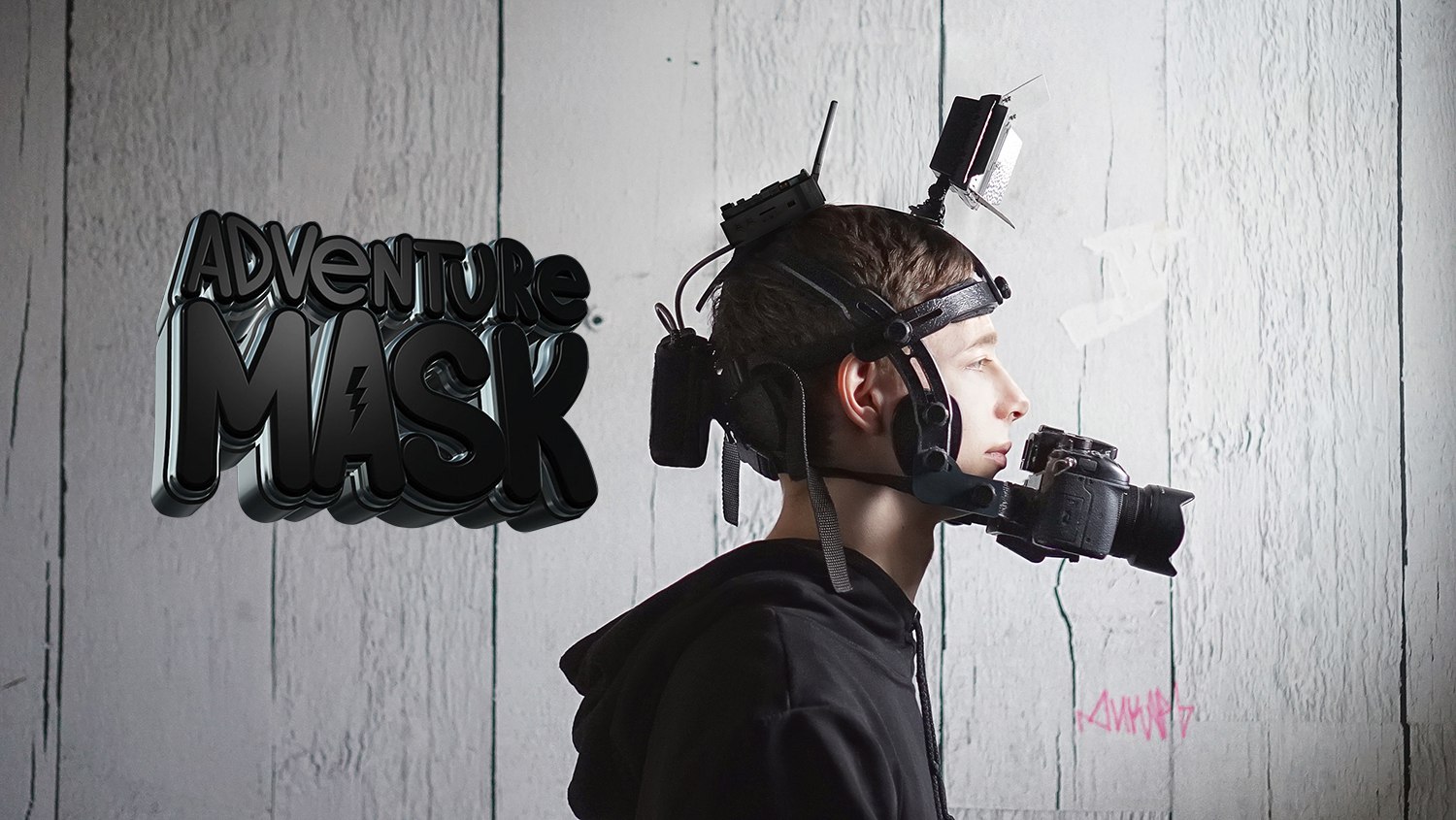Introducing the game-changing camera mounting system, originally used to capture the jaw-dropping stunts in the world's first action POV movie, 'Hardcore Henry.' Get ready to unleash the full potential of first-person action filmmaking!
The Concept:
Adventure Mask: The world's inaugural fastening solution tailor-made for professional-grade, first-person cinematography.
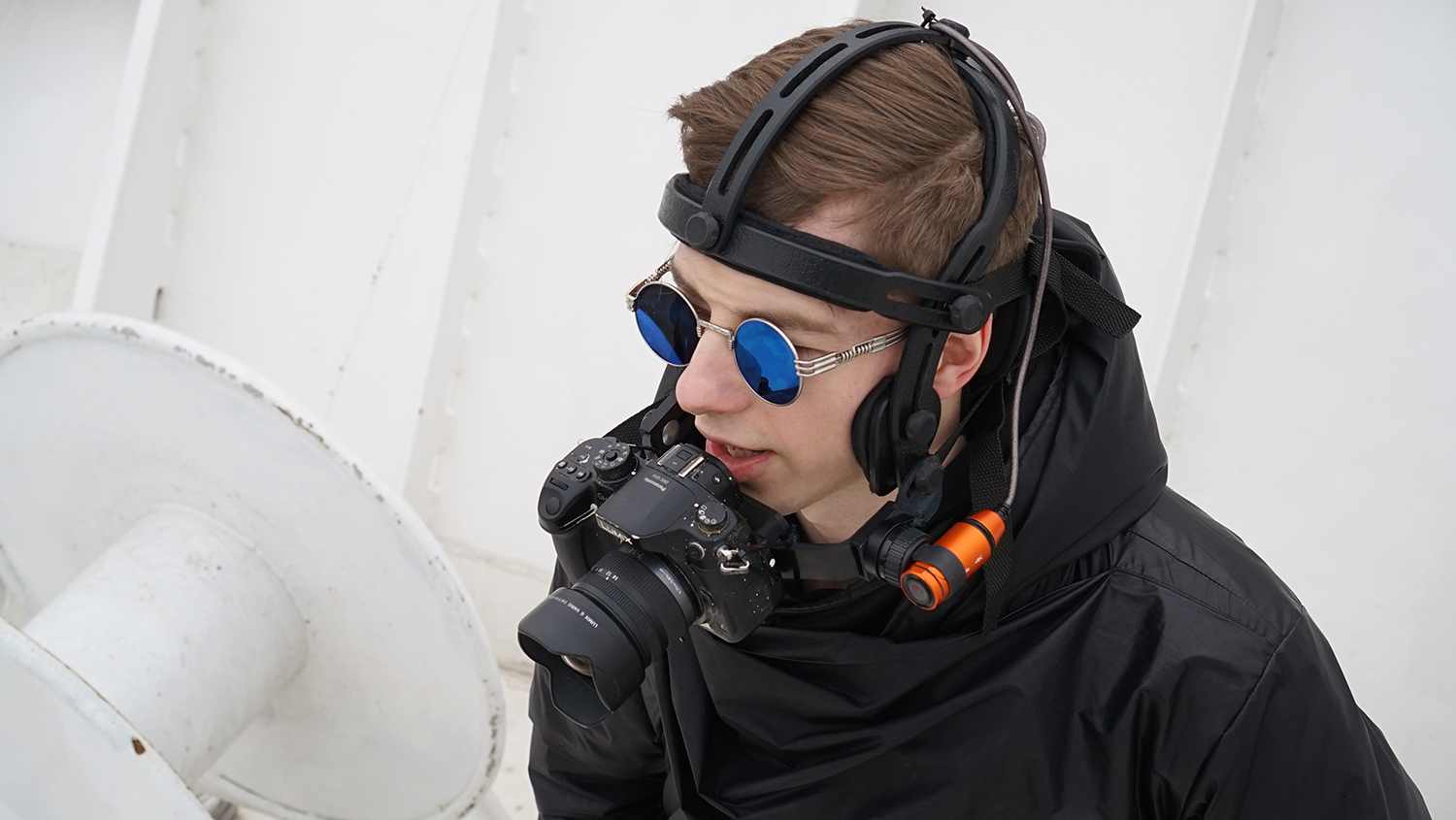
Crafted with a vision in 2013 and secured by a Russian patent (RU 2013156444 dated 19.12.2013), this ultra-lightweight rig was designed by moi to secure a wide array of cameras and equipment. Its prime directive?
To remain feather-like, universally fitting for any head shape, and effortlessly collapsible for transport without being a space hog. All this while providing an unobstructed view and boasting incredible durability.
To remain feather-like, universally fitting for any head shape, and effortlessly collapsible for transport without being a space hog. All this while providing an unobstructed view and boasting incredible durability.
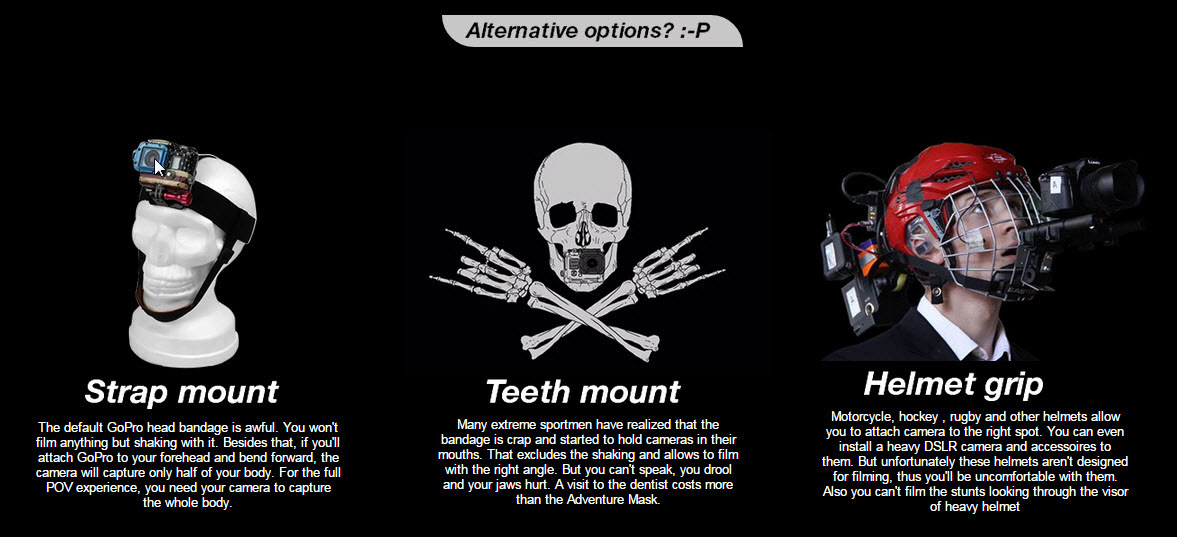
Creating the Perfect Mount:
When I set out on this project, there wasn’t a single mount on the market that met my needs. As a filmmaker aiming for that first-person perspective, I was left with no choice but to craft my own solution.
The core idea was clear: all existing alternatives fell short in so many ways.
Strap Mount:
The usual action cameras head strap? Total disaster. It captures every shake and wobble. Lean forward? Your audience is stuck with a half-view of your upper body. To truly immerse them, you need a camera that sees it all.
Teeth Mount:
Some adrenaline junkies tried the mouth-mount approach, thinking it was groundbreaking. It does steady the footage, but try having a conversation or even breathing without turning into a slobbering mess. Oh, and the dental fees? They're more terrifying than any stunt you’d pull.
Helmet Grip:
Sure, there's the tried-and-true helmet mount. Great for biking, hockey, rugby, etc. But let’s be real: these helmets weren’t designed for professional filming. Lugging around a bulky DSLR, getting those weird angles, and, man, forget about seeing through that visor. Comfort? Definitely not included.
The usual action cameras head strap? Total disaster. It captures every shake and wobble. Lean forward? Your audience is stuck with a half-view of your upper body. To truly immerse them, you need a camera that sees it all.
Teeth Mount:
Some adrenaline junkies tried the mouth-mount approach, thinking it was groundbreaking. It does steady the footage, but try having a conversation or even breathing without turning into a slobbering mess. Oh, and the dental fees? They're more terrifying than any stunt you’d pull.
Helmet Grip:
Sure, there's the tried-and-true helmet mount. Great for biking, hockey, rugby, etc. But let’s be real: these helmets weren’t designed for professional filming. Lugging around a bulky DSLR, getting those weird angles, and, man, forget about seeing through that visor. Comfort? Definitely not included.
By the way, the market has since seen some heavy-duty camera helmet mounts pop up. But they’re so clunky, they'd weigh you down during any trick or stunt...
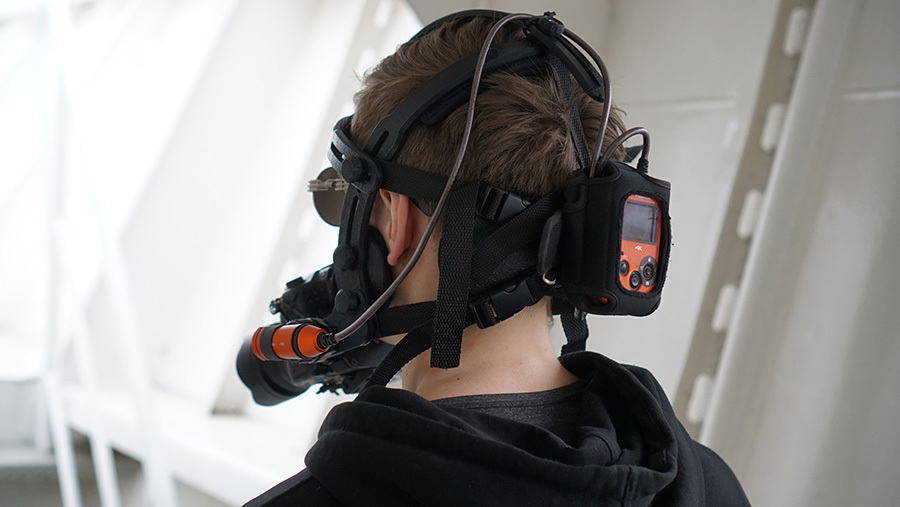
The Adventure Mask Blueprint:
The primary frame of the mask is crafted from durable sheet plastic, fortified with aviation-grade aluminum around the jaw area. This boosts strength and ensures top-notch protection for your camera. The Adventure Mask is not only cost-effective to produce but its modular design also guarantees easy and affordable parts replacement should wear or breakage occur.
Weighing in at just about 600 grams, the mask might seem light. But don't be fooled! Its sturdy prototype can support equipment weighing up to 6 kilograms. In simpler terms? Your neck will likely give out under the pressure way before this mask ever does.
The primary frame of the mask is crafted from durable sheet plastic, fortified with aviation-grade aluminum around the jaw area. This boosts strength and ensures top-notch protection for your camera. The Adventure Mask is not only cost-effective to produce but its modular design also guarantees easy and affordable parts replacement should wear or breakage occur.
Weighing in at just about 600 grams, the mask might seem light. But don't be fooled! Its sturdy prototype can support equipment weighing up to 6 kilograms. In simpler terms? Your neck will likely give out under the pressure way before this mask ever does.

Universal Accessory Compatibility!
Crafted for compatibility, this mask seamlessly meshes with classic mounts of popular gear. Whether it's lights, mics, radio transmitters, monitors, or even wireless focus systems with the right accessory — it's got you covered.
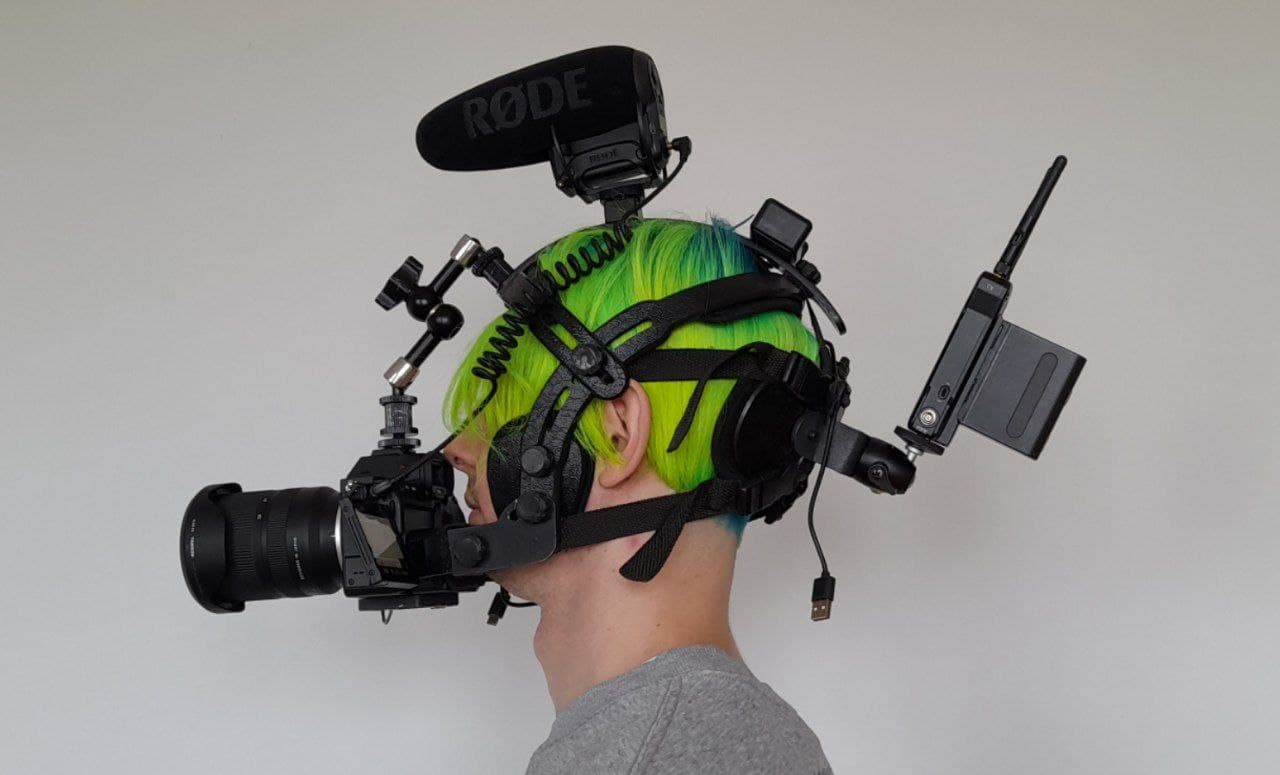
The pre-production prototype underwent rigorous testing with a variety of cameras, excelling with both action cams and mirrorless models like the Sony A7S3.
For the heavyweight cameras, you might need an additional stabilizing 'Magic Arm' mount. Sure, it slightly reduces the operator's view, but it still offers unmatched mobility, outclassing any helmet-form solution out there.
For the heavyweight cameras, you might need an additional stabilizing 'Magic Arm' mount. Sure, it slightly reduces the operator's view, but it still offers unmatched mobility, outclassing any helmet-form solution out there.
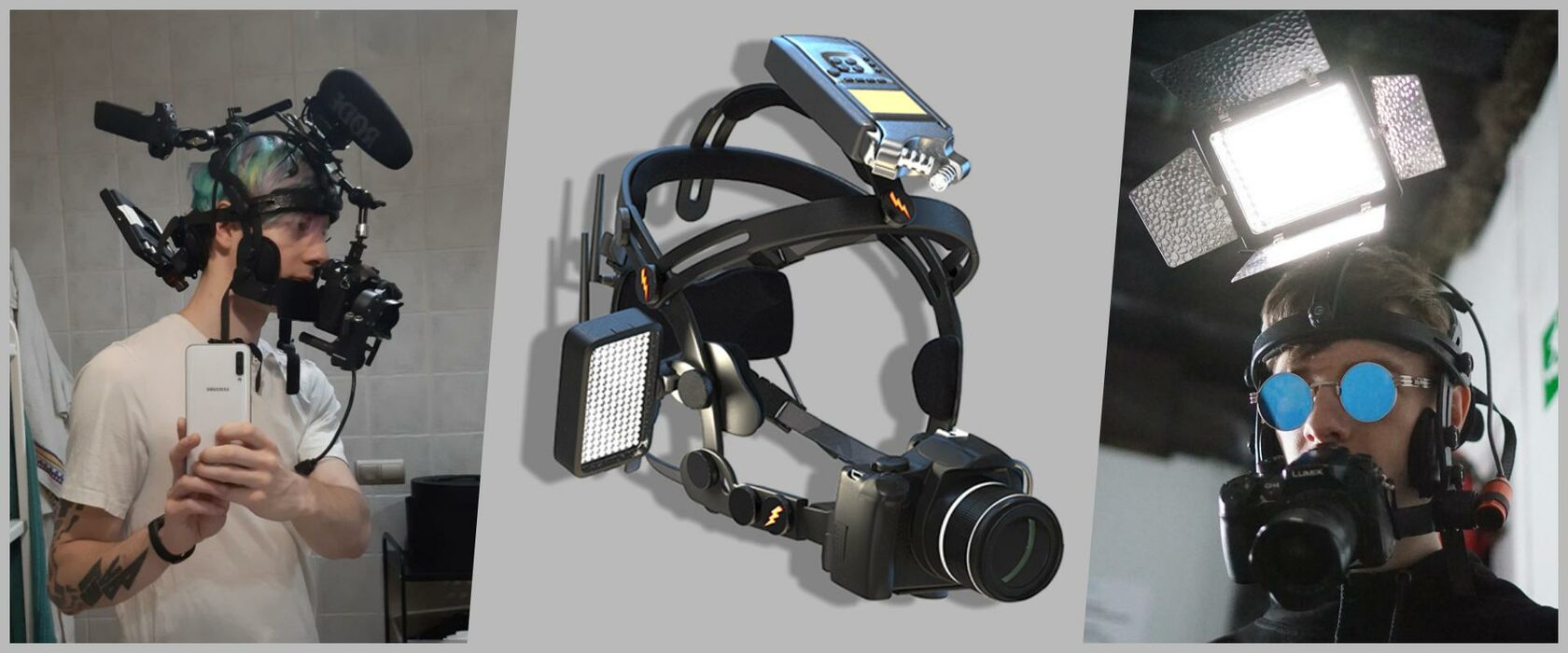
The mask's design caters to both indie filmmakers and adrenaline junkies. That's why it's fully open, well-ventilated, and a breeze to wear.
In layman's terms: No sweaty brow, no strained neck, clear vision of your shots, and your wallet won't feel the burn. That's the Adventure Mask advantage.
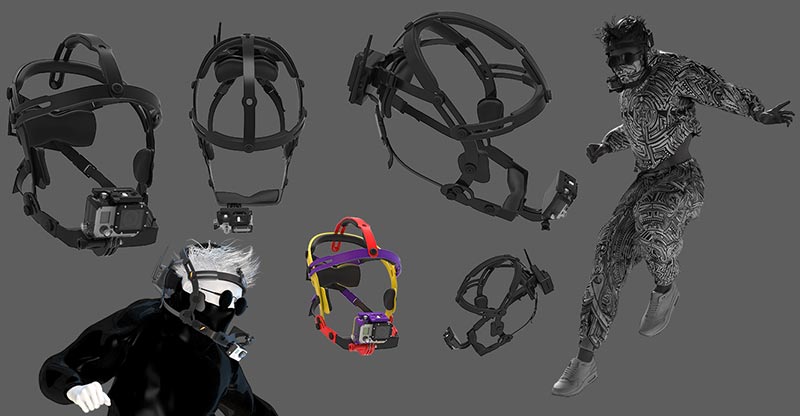
Competitors? Ha! From 2013 to 2023, nobody's come up with anything better in this niche.
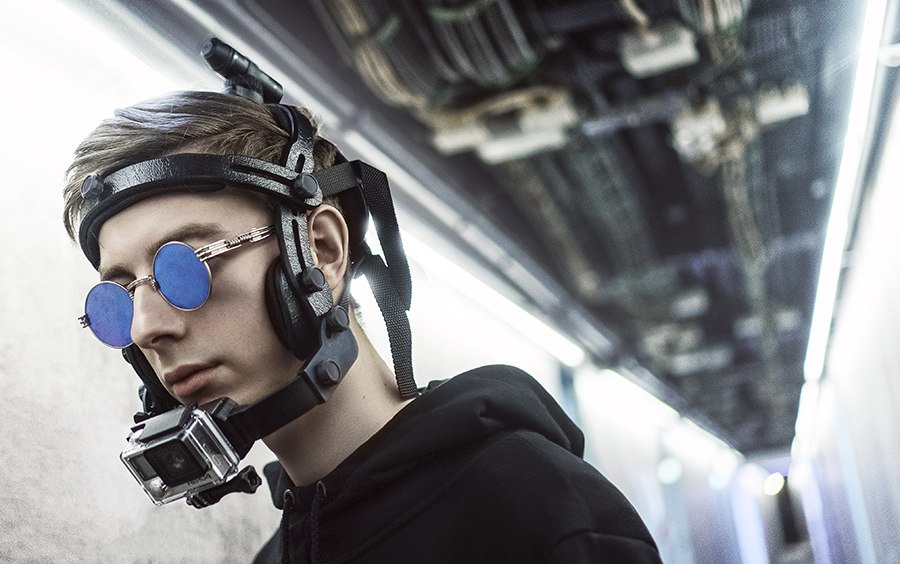
When filmmakers hand over the Adventure Mask to adrenaline seekers and pair it with lighter cameras, its full potential unfolds. You can remove the central stabilizing bar, making the mask ultra-light, granting you a 100% field of view, and unrestricted movement. No more straining your neck! Plus, with the camera not lodged between your chompers, you can chat away and record sound.
Behold, the true essence of first-person shooting freedom.
Behold, the true essence of first-person shooting freedom.
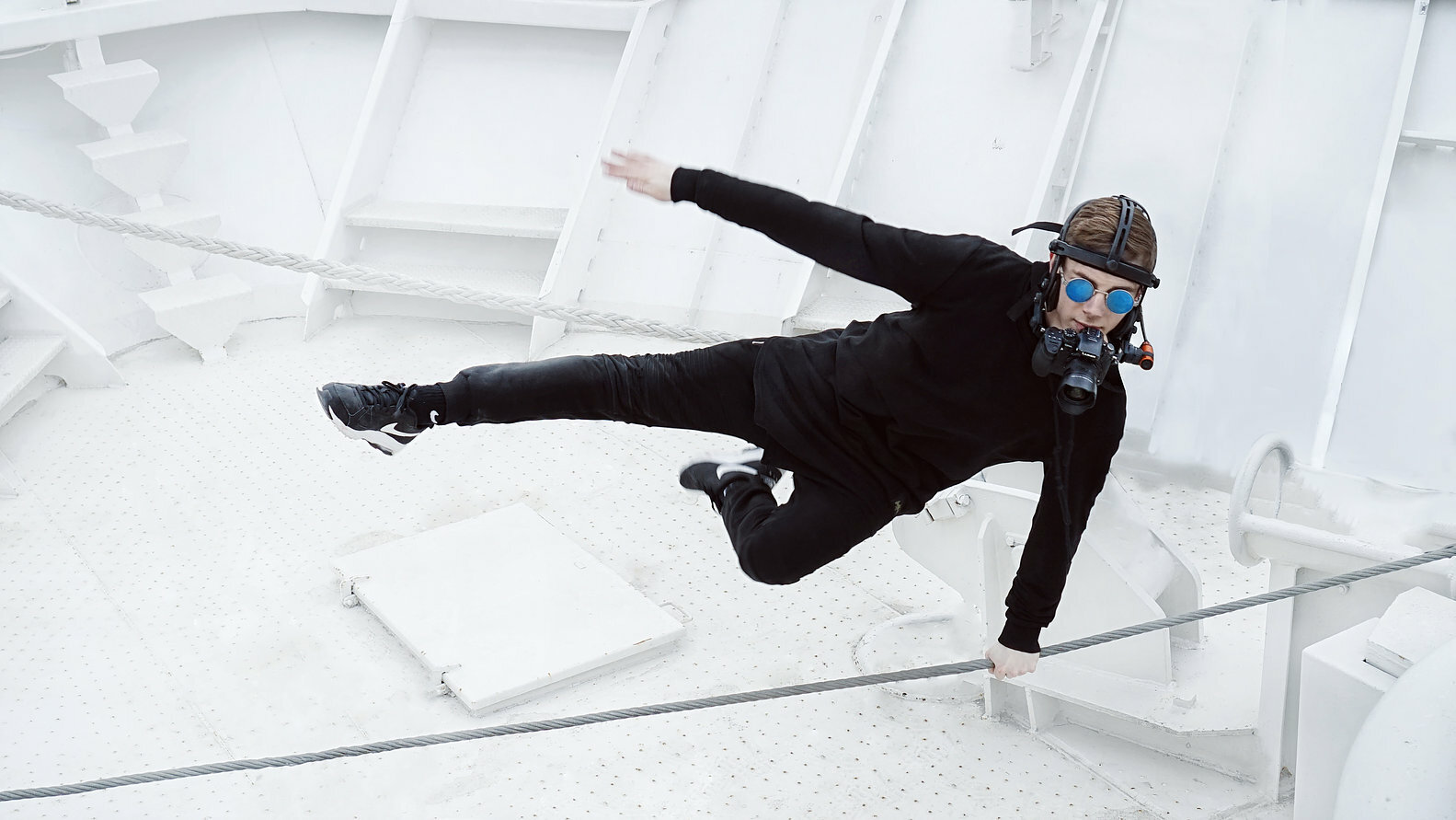
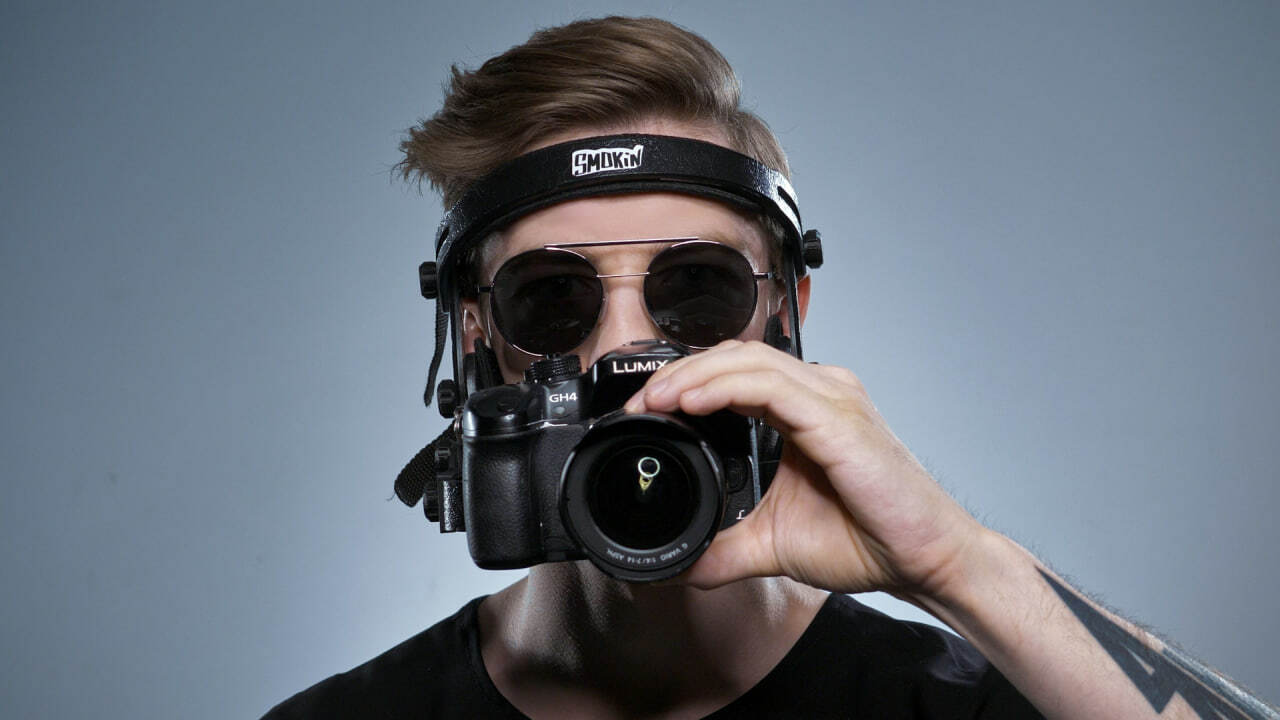
The Genesis and Evolution of the Project
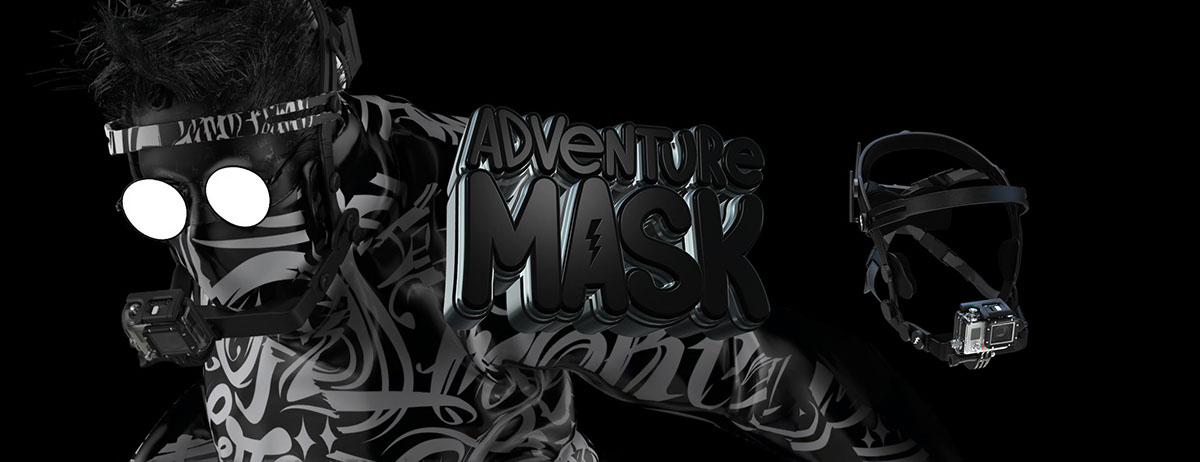
2008
The action cam market was like an undiscovered country, pretty much nonexistent. Those cameras that would've been decent for POV shots were still dreaming of hitting HD. Me? I had been itching for a couple of years to shoot my parkour exploits first-person style. So I scoured the Russian market for a lightweight, portable camera with a wide-enough angle to capture my sick moves. But no dice, nothing out there met my needs.
That's when the light bulb went off. Why not rig up one of those cheap, lightweight surveillance cameras for the job?
The recipe was bare bones: Strap the camera to a cap, and tuck a video recorder with live digitizing into a backpack, tangled with a mile of wires, and lug that sucker around on your back.
Sure, the video quality was garbage, the editing was a hot mess, but damn, it was the first step towards creating a POV helmet cam… We rolled out the first video ever using a first-person viewpoint.
That's when the light bulb went off. Why not rig up one of those cheap, lightweight surveillance cameras for the job?
The recipe was bare bones: Strap the camera to a cap, and tuck a video recorder with live digitizing into a backpack, tangled with a mile of wires, and lug that sucker around on your back.
Sure, the video quality was garbage, the editing was a hot mess, but damn, it was the first step towards creating a POV helmet cam… We rolled out the first video ever using a first-person viewpoint.
2009
The quality of our first video was, let's be honest, begging for mercy. That analog camera’s image shook like a leaf in a hurricane during runs, and the field of view was as narrow as a rat's alley. I needed a fresh idea, and bingo, it hit me...
Want to truly bring your audience into the POV scene? Ditch the forehead cam setup—that’s old news. Even with a 170-degree angle, you're missing out on that immersive 'you-are-there' vibe. Why? Because your peepers naturally catch a glimpse of your body from the neck down, creating a sense of self within the space. Cameras strapped to your forehead? Not so much.
The fix is a game-changer: Slide that wide-angle lens down to mouth-level. That’s where the magic happens—where the visual feast of full presence is served.
The first prototype was hammered out in 2009 from an old motorcycle helmet gifted by my buddies, the motocross freestylers from team FERZ (FMX.RU). That helmet got a makeover and a paint job from designer Ivan Solomin. We just clamped the helmet’s visor around the mouth region and screwed on a sturdy case for a CANON point-and-shoot. The solid helmet stopped the camera from shaking, but the damn thing weighed a ton – too heavy for non-moto stunts. So, the POV shooting dream got shelved for the time being…
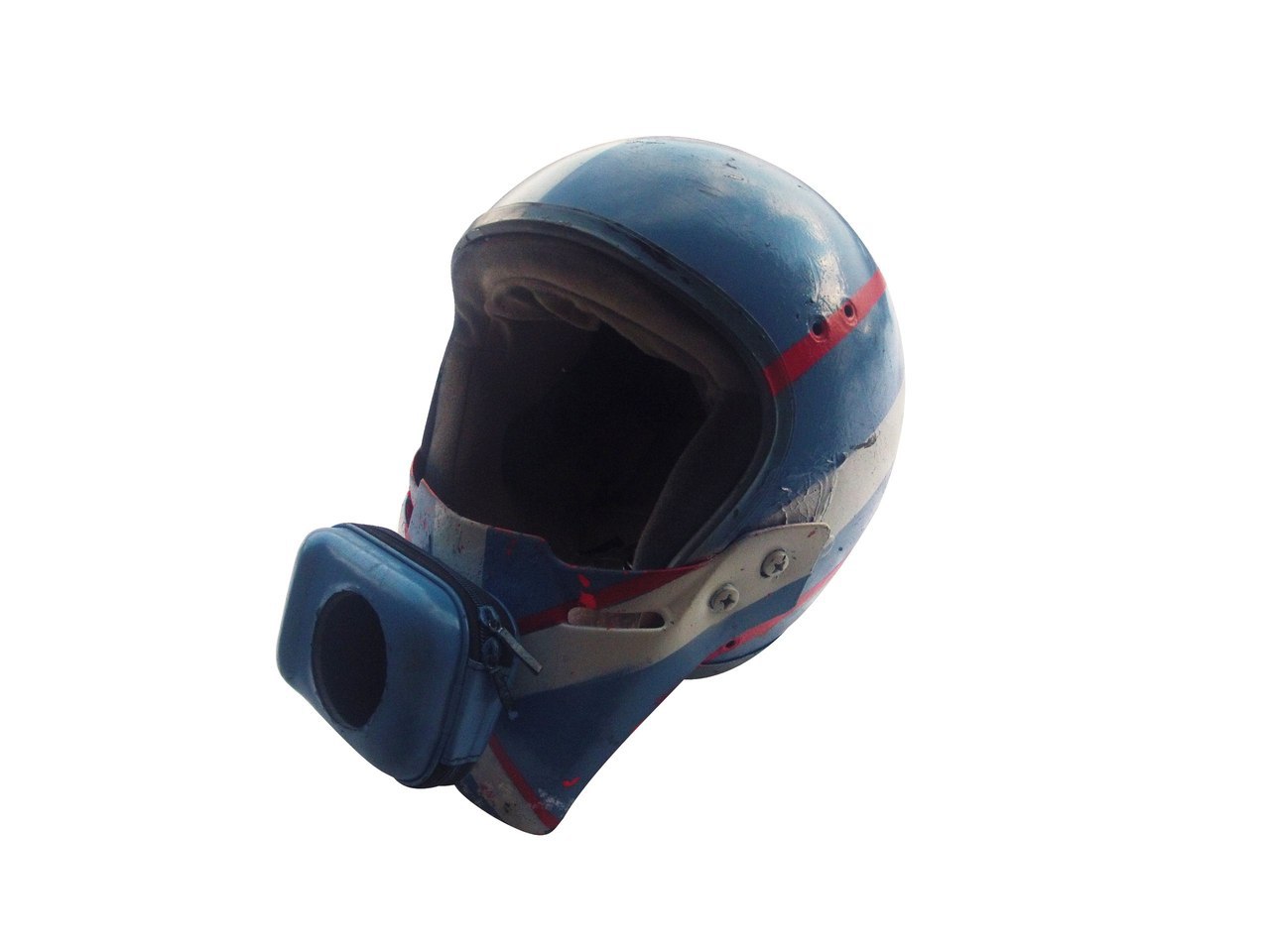
2011
A friend of mine director Ilya Naishuller, aiming to skyrocket his band's fame, kept churning out music videos. But Russian TV had indie punk music in its bad books, and the clips were too polished for the gritty world of the internet. So the band's popularity didn't exactly go through the roof. Ilya was on a quest for a genius idea to introduce new souls to the art of Biting Elbows.
Just then, an action camera revolution kicked in with the arrival of the GoPro HD camera on the market, snagged by Ilya on a Euro trip. He tossed it my way for a couple of days, and I slapped that baby onto my forehead and cranked out a parkour practice vid.
Just then, an action camera revolution kicked in with the arrival of the GoPro HD camera on the market, snagged by Ilya on a Euro trip. He tossed it my way for a couple of days, and I slapped that baby onto my forehead and cranked out a parkour practice vid.
The footage floored Ilya to the point where he hit me up just minutes later,
laying it out plain and simple:
-"We've got to make a music video in this style."
That call kick-started my gig as a camera operator. I was clueless about what to do next, and Ilya? Well, he was flying pretty blind about the road ahead too.
We pulled together, went full-on creative blitz for a couple of weeks, and boom – we sspawned a DIY blockbuster costing three pizzas, one pyrotechnic bang, and a couple of bargain bin costumes.
Taking cues from my POV helmet saga, we scored a Predator mask from a tactical gear shop – as lightweight as hype, with a fit that clung to the face like gossip. Initially, we just MacGyvered the camera on with duct tape.
Taking cues from my POV helmet saga, we scored a Predator mask from a tactical gear shop – as lightweight as hype, with a fit that clung to the face like gossip. Initially, we just MacGyvered the camera on with duct tape.
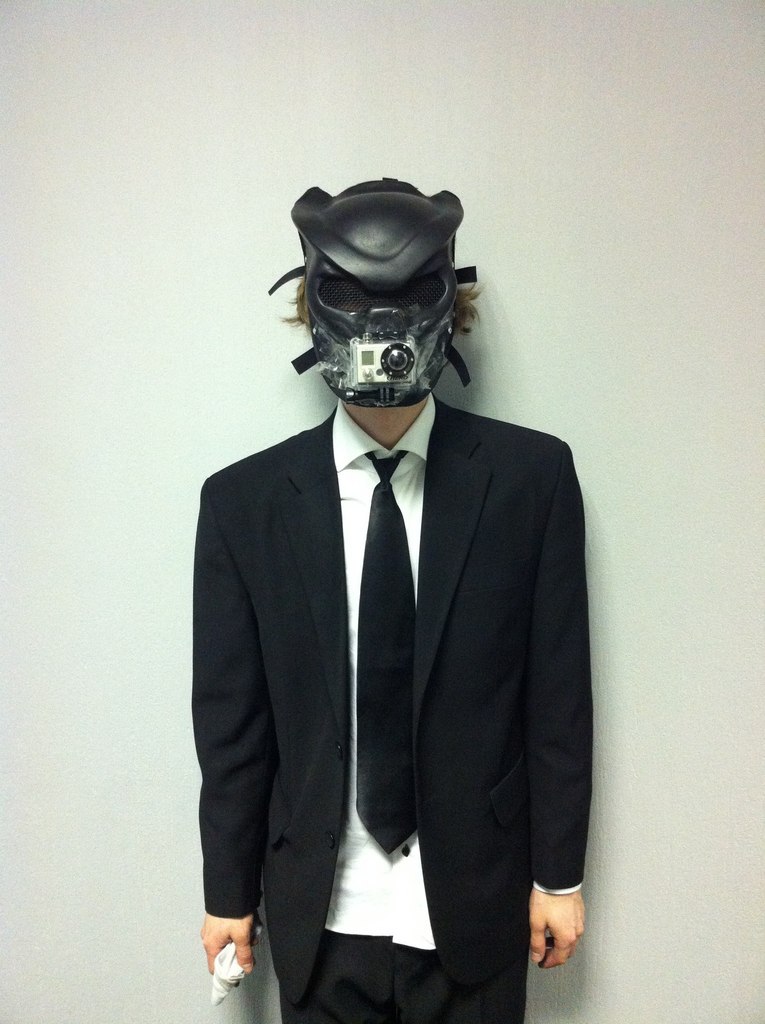
But then, we chopped off the front for that jaw-dropping view. This beautiful monstrosity became the first-ever device for filming stunts from a first-person view and the forefather of the Adventure Mask prototype.
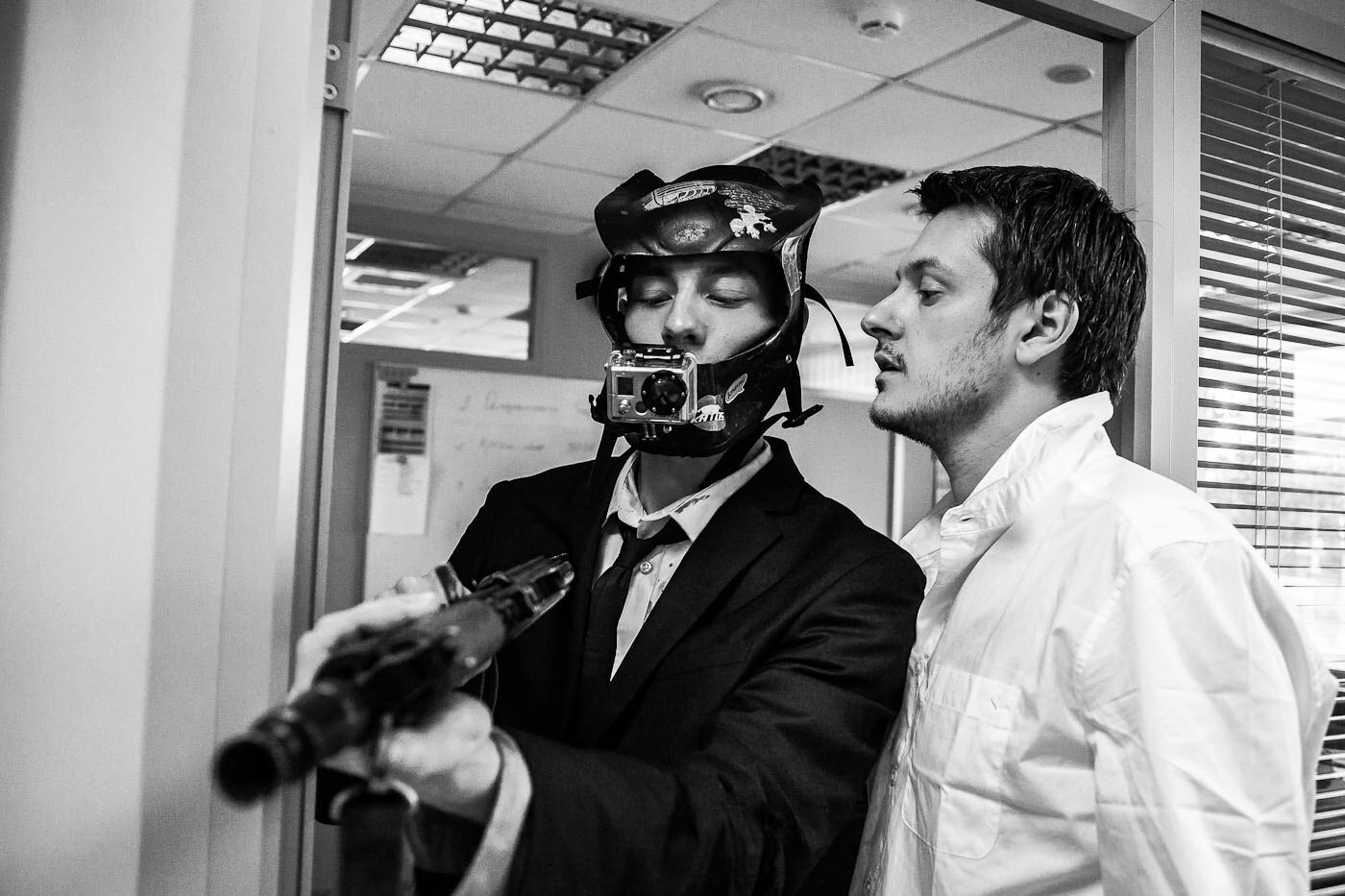
The video went viral, racking up over 11 million views. Top music magazines wrote about the band, landing them a deal with a major music label and their track scored a spot on the soundtrack for the movie "What else Men Talk About."
It’s a no-brainer that the video catapulted the band in the right direction. Within the next year, their resume boasted gigs not just in Moscow’s premier clubs, but also at the OLYMPIC Stadium. These guys shared the stage with the likes of PLACEBO, LINKIN PARK, and Guns N' Roses...
It’s a no-brainer that the video catapulted the band in the right direction. Within the next year, their resume boasted gigs not just in Moscow’s premier clubs, but also at the OLYMPIC Stadium. These guys shared the stage with the likes of PLACEBO, LINKIN PARK, and Guns N' Roses...
2012
Riding the high of that first smash hit, the grind kicked in with rehearsals, brainstorming sessions, and gearing up to shoot the sequel to the music video.
While juggling the sequel's preps, I hit my limit with the clunky old paintball helmet and got dead serious about crafting a custom POV rig. I scribbled down the specs for the ultimate POV mount like some Hollywood tech wizard:
- The camera's gotta snap on near the mouth – no ifs, ands, or buts.
- The shooter needs a peek at the monitor whenever they damn well please.
- The rig can't block the view - camera peeking out is the only exception.
- This baby needs to be light as a feather, not squash your face, and never get in the way of a good chat or a snack.
- It's gotta have slick size adjustments and built-in ports for all that extra jazz.
- The rig should have open-air, head-cooling, zero-sweat design.
During this period, I elevated my training, focusing on the art of first-person shooting and contemplating shot composition even amidst the adrenaline rush. I went the extra mile to revamp the 'Predator' mask, enhancing it beyond its original design. All these efforts paid off immensely during the filming of our new music video...
2013
The sequel to Insane Office Escape dropped, titled "Bad Motherfucker," and it blew the internet's collective mind. (You can get the full scoop on it over at a dedicated page in my portfolio.)

At that point, I hit up my buddy, the artist Gleb Reznichenko, asking him to sketch out my brainwaves about the helmet's structure. Dude listened to my ramblings and whipped up the first batch of concept art, which I proudly slapped on the wall.
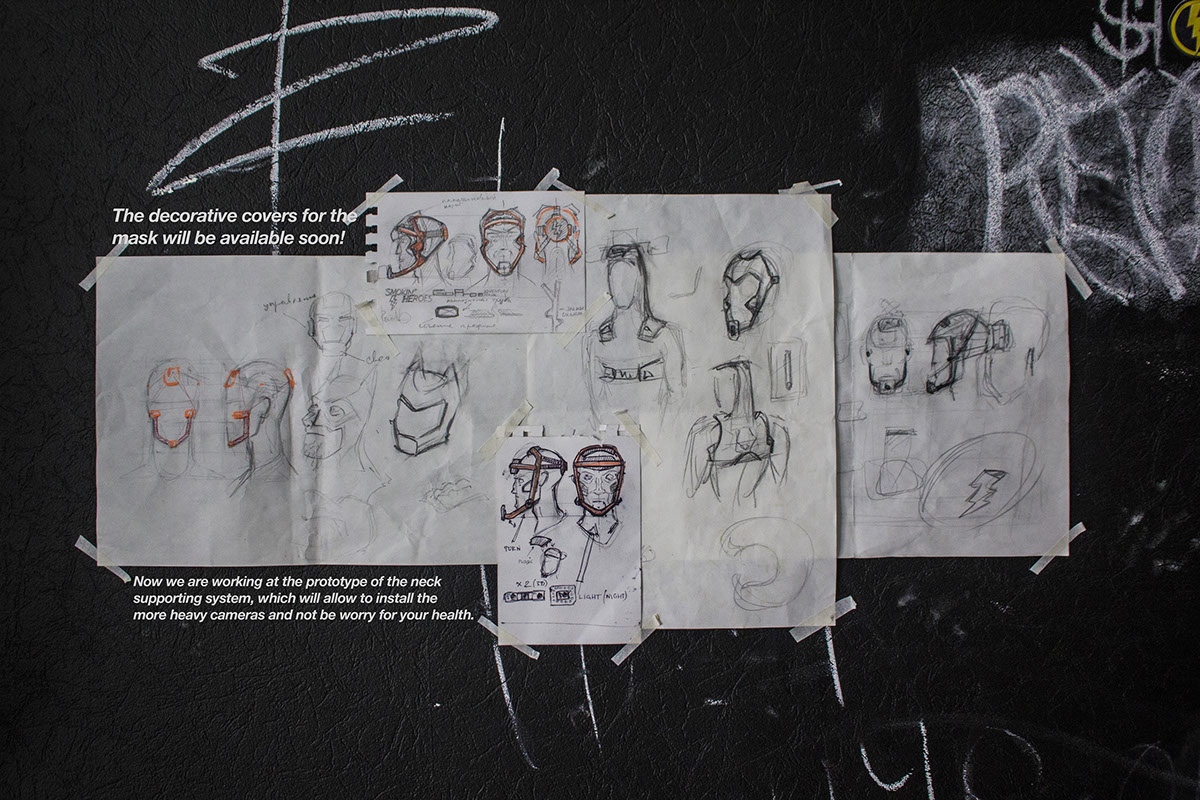
Gleb and I chewed over new tweaks for the rig, streamlining that bad boy until we reached the visualization stage. Then the 3D maestros, Roma Bilichenko and Mikhail Kuznetsov, jumped aboard, bringing us closer to grasping what the final product might look like... It was prototype o'clock.
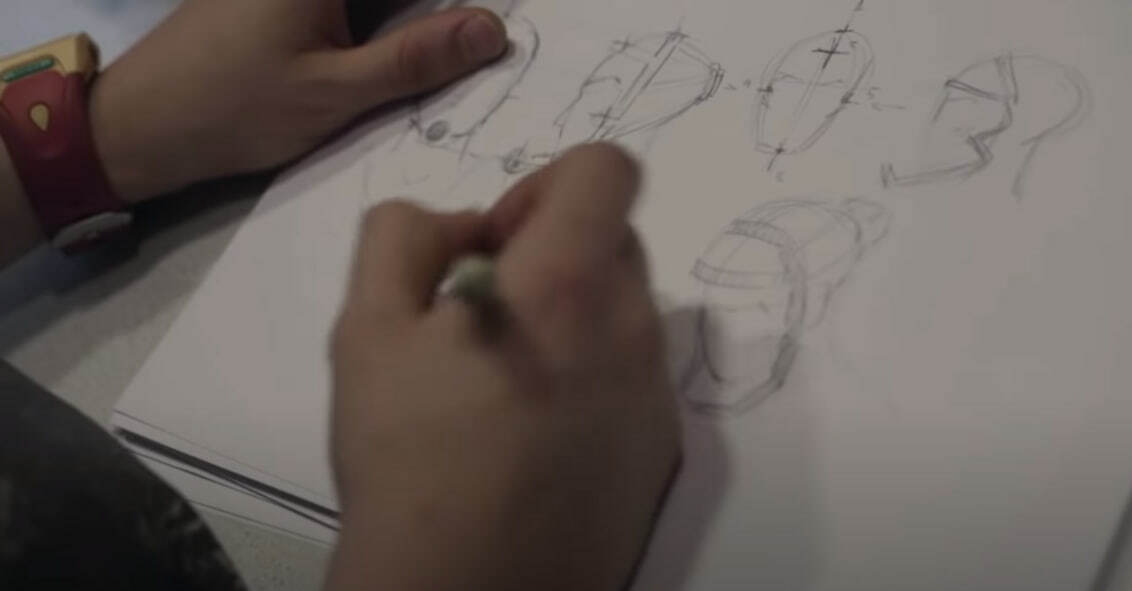
The online buzz around our video caught the attention of Oleg Savin, the tactical gear manufacturer who created the original airsoft Predator mask we bought for our video. He reached out and offered to collaborate. His company Gear Craft had the resources for prototype production (machinery, seamstresses, staff), while I had a team of designers, the initial helmet blueprints, and a clear vision for the future device.

But let’s be straight - our first real products were as durable and comfortable as a chocolate teapot. Therefore, the design of the Adventure Mask was in constant flux.

The TV reports, comments from international stars, and a tremendous number of views on the "Bad Motherfucker" video led to producer Timur Bekmambetov calling Ilya Naishuller to propose making a feature film.

Seizing the opportunity, Ilya immediately called me to brainstorm ideas for the film and to shoot it from the perspective of the protagonist, Henry, acting as the camera operator. Within a few weeks, we turned action scenes inside out, got the green light from Timur, and then Ilya locked himself away to write the script, crafting the plot around the action we'd envisioned...
And me? I got an extra boost to refine the mask's design.
And me? I got an extra boost to refine the mask's design.
2014
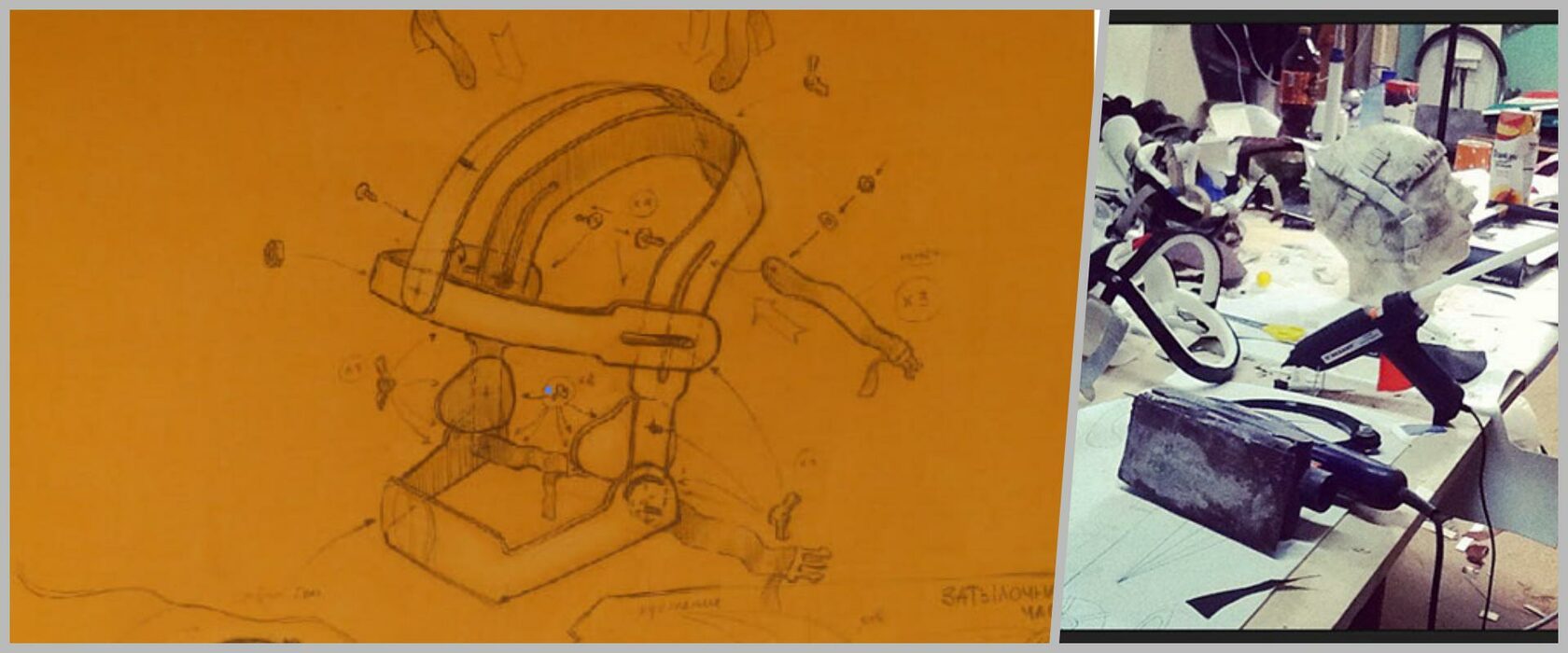
Discussing the project, we realized that for a feature film, we needed a real cinematographer, which I was not at the time. Up until that point, I'd only shot a couple of music videos with a shoestring budget and had no clue what lighting devices were called on a film set.
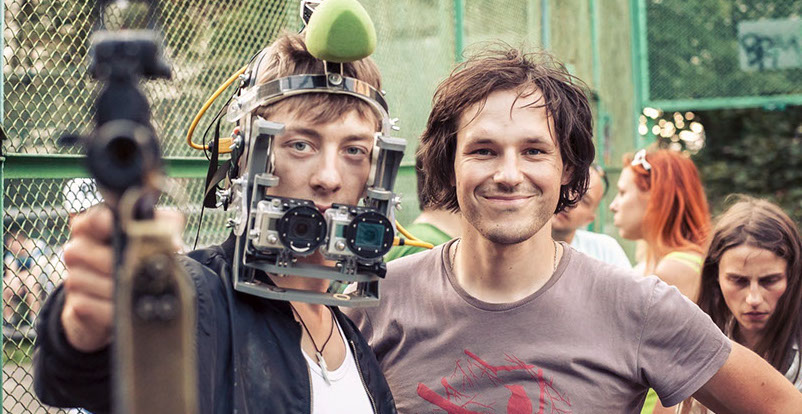
Therefore, we brought in cinematographer Vsevolod Kaptur, who not only taught me the art of filmmaking but also contributed to developing the camera stabilization system for the helmet used in the movie.
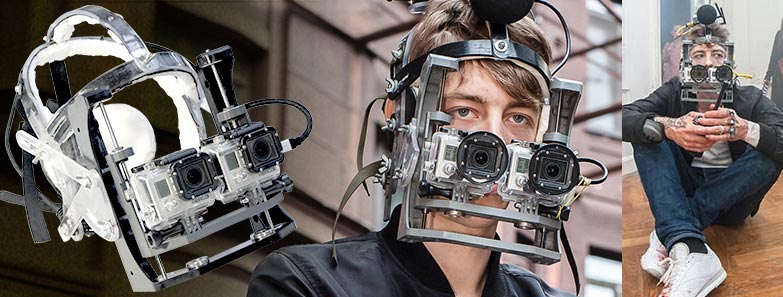
Reflecting on the project, it's clear that the magnetic stabilization system engineered by Vlad and his team wasn't as effective as we'd desired. Its considerable limitation on visibility thwarted some of the complex shots and undermined the innovative ideas I had envisioned for the mask without the added equipment.

Ideally, I would have preferred a portable three-axis electronic stabilization, which wouldn't have compromised the field of view, and while I had conceptualized its design, we didn’t have a working prototype at hand. Given that electronic systems at the time were notoriously unreliable, and with Ilya’s liberal use of stage blood potentially leading to short circuits mid-shot, we had to forgo this option.


Moreover, we were in the midst of the filming process, leaving us no time for extensive planning and designing. Thus, all technological solutions had to be tested and refined on the fly. My mask prototypes frequently broke down, and Vlad's team was persistently patching up the stabilization system to keep us on track.
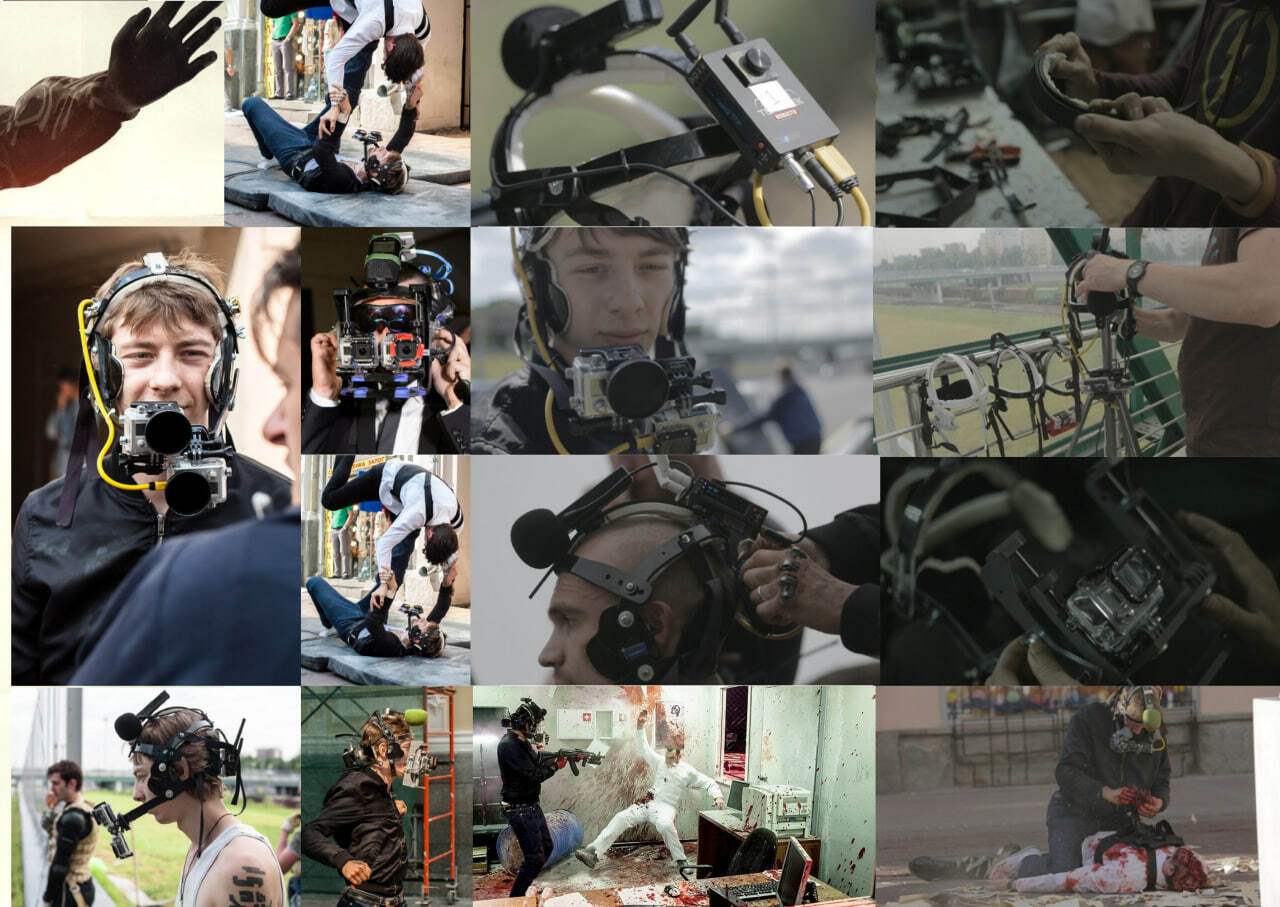
During the filming process, we ran the gauntlet with a multitude of prototypes – each met their demise in the relentless pursuit of perfection. Yet, none crossed the finish line boasting the title of 'good enough.'

The bags under my eyes in the photo below are a testament to how little Vlad and I slept during the initial filming days, as we endeavored to tweak the shooting process until the equipment finally stopped malfunctioning...

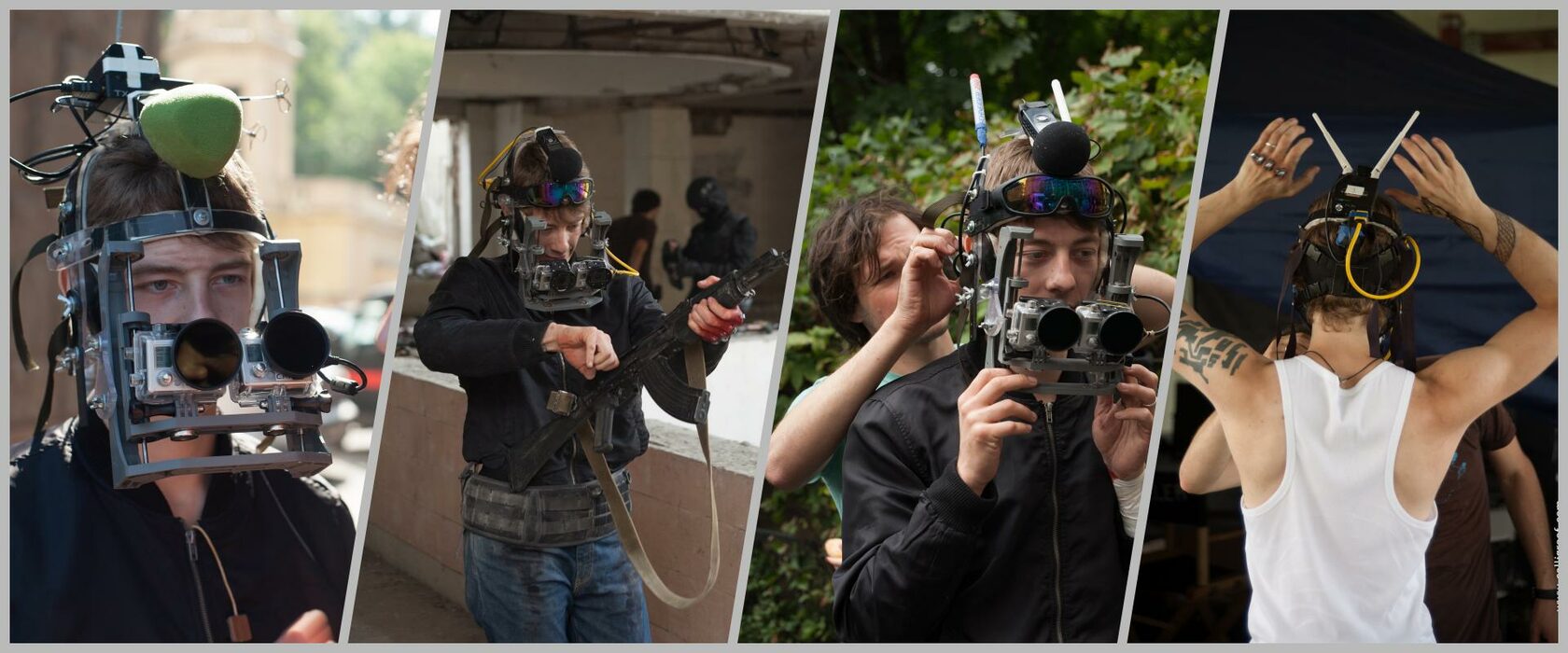
Check out the behind-the-scenes action where the film crew, shooting a feature on me, dropped in on one of our training sessions. We were gearing up with stunt performers for the film's combat scenes. The footage captures a variety of masks that were in play at the time.
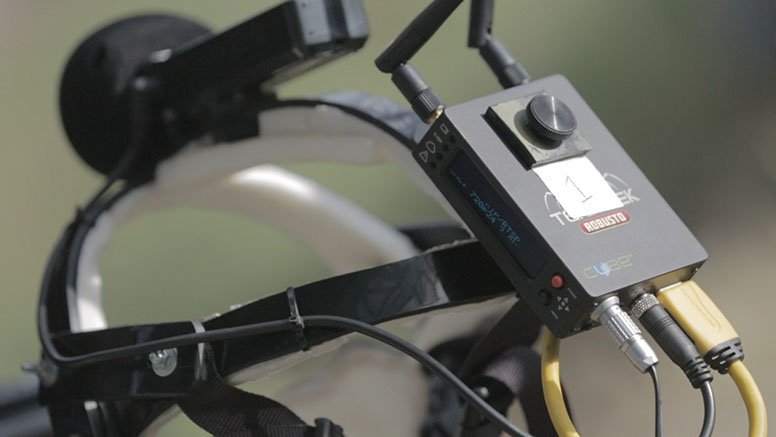
For an inside look at the grit and grind of our working conditions, and to get a real sense of how the mask's design came to life, just check out one of the official 'making-of' featurettes of our film.
2015
Our film is smoothly transitioning from the hustle of shooting to the finesse of post-production, with a side order of reshoots on the horizon. Meanwhile, I'm recuperating from on-set injuries and stepping back from the production chaos. This downtime is a breeding ground for a brainstorm on how to polish the Adventure Mask design. I'm all about transforming it from a rough prototype to a user-friendly, comfort-first piece of essential gear.
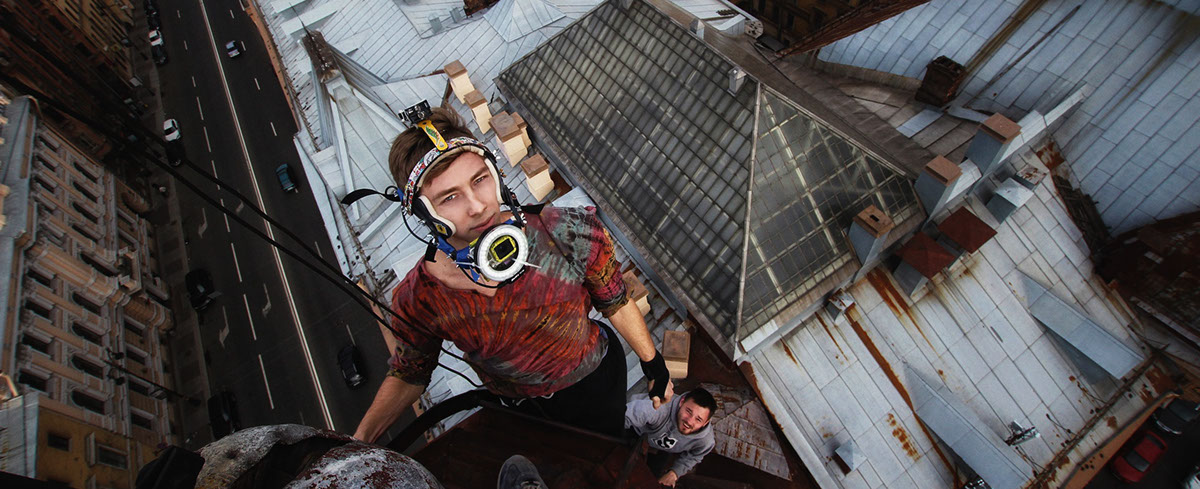
"I'm starting to travel more, refining the design with the eye of an extreme sports athlete, rather than just a filmmaker."
And finally, the mask has achieved its definitive shape, time-tested and refined.
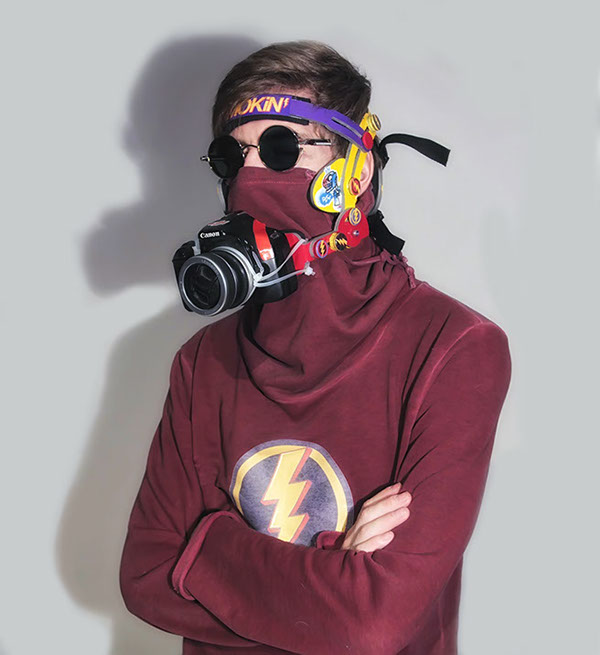
As "Hardcore Henry" was gearing up for release and to gather the necessary funds for the final touches in post-production, we launched a Kickstarter campaign where the Adventure Mask became one of the exclusive rewards for our backers.
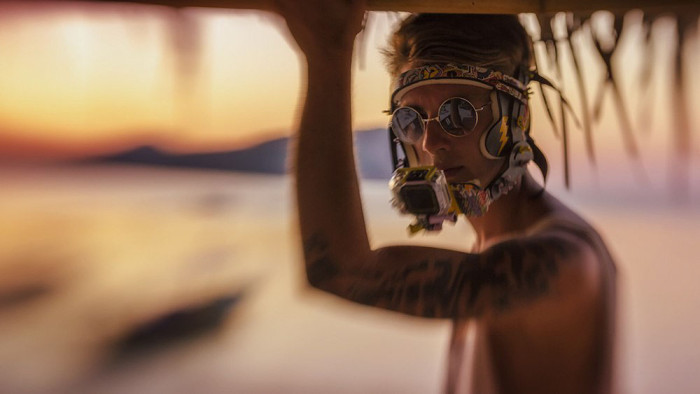
It was at this juncture that I made several enhancements to the design, collaborating with my engineering buddies at Research Creations Park to produce a limited run of 100 units of the Adventure Mask.
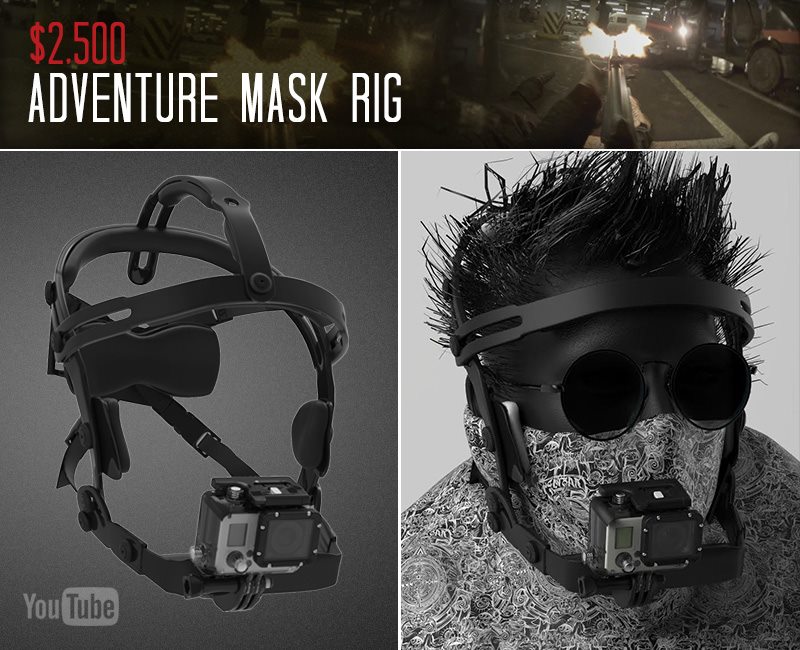
For this special batch, I even took on the design of the packaging myself.
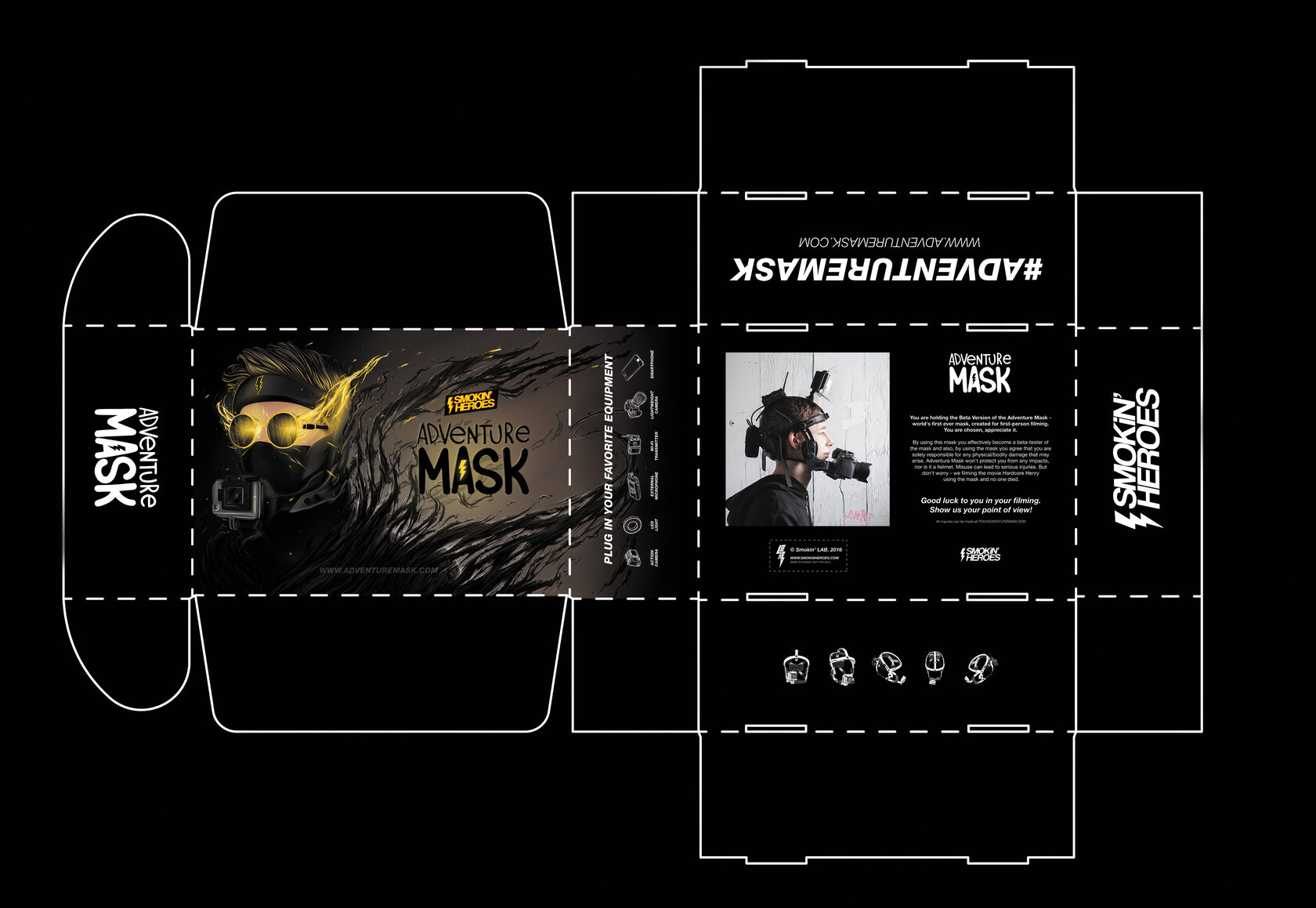
2016
Following the film's release, fame came knocking. Overnight, Ilya became a sought-after director, and I was inundated with collaborations as a Director of Photography. I launched my own production company, Cameraptor, and began globetrotting, honing my cinematic skills and producing new, buzz-worthy projects.
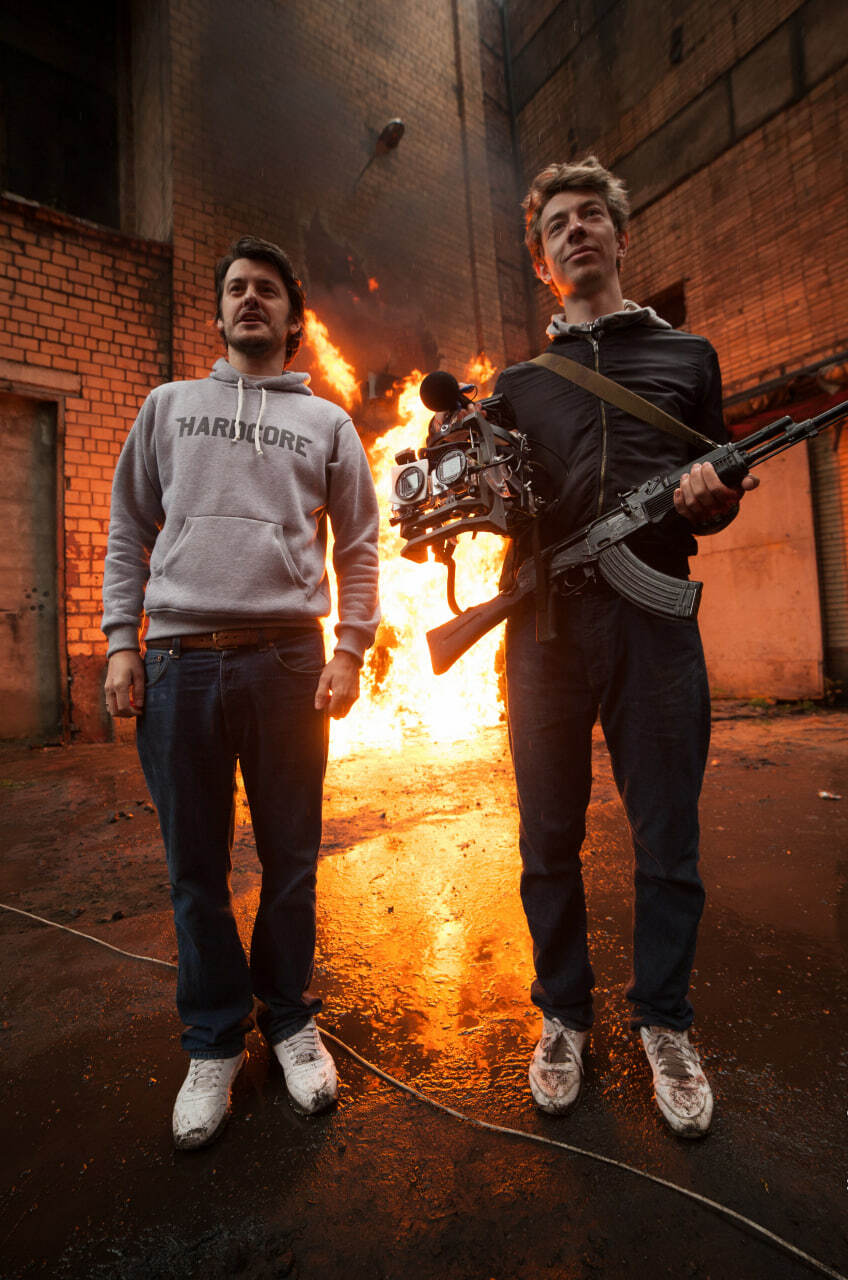
Yet, the idea that my innovations should evolve into a bona fide commercial product haunted me.
I had amassed a plethora of ideas and design drafts for Adventure Mask 2.0, ripe for mass market release as a consumer product with a defined target audience. I was flooded with thousands of emails from people eager to purchase the mask, yet unable to do so.
But back in 2016, my entrepreneurial savvy was still green; I was clueless about scaling production, navigating Chinese manufacturing, and building tech accessory brands for cameras. The right partners and investors for this venture eluded me, and I had to be real with myself: I'm an innovator and creator, not a merchant.
A thrilling career path was unfolding before me, one that was destined to materialize. As for the Adventure Mask, it remained an exclusive rig that I, as a director and cinematographer, continued to use in my personal projects.
Take, for example, the "Russian Ninja Warrior" commercial I filmed using the Adventure Mask.
I had amassed a plethora of ideas and design drafts for Adventure Mask 2.0, ripe for mass market release as a consumer product with a defined target audience. I was flooded with thousands of emails from people eager to purchase the mask, yet unable to do so.
But back in 2016, my entrepreneurial savvy was still green; I was clueless about scaling production, navigating Chinese manufacturing, and building tech accessory brands for cameras. The right partners and investors for this venture eluded me, and I had to be real with myself: I'm an innovator and creator, not a merchant.
A thrilling career path was unfolding before me, one that was destined to materialize. As for the Adventure Mask, it remained an exclusive rig that I, as a director and cinematographer, continued to use in my personal projects.
Take, for example, the "Russian Ninja Warrior" commercial I filmed using the Adventure Mask.
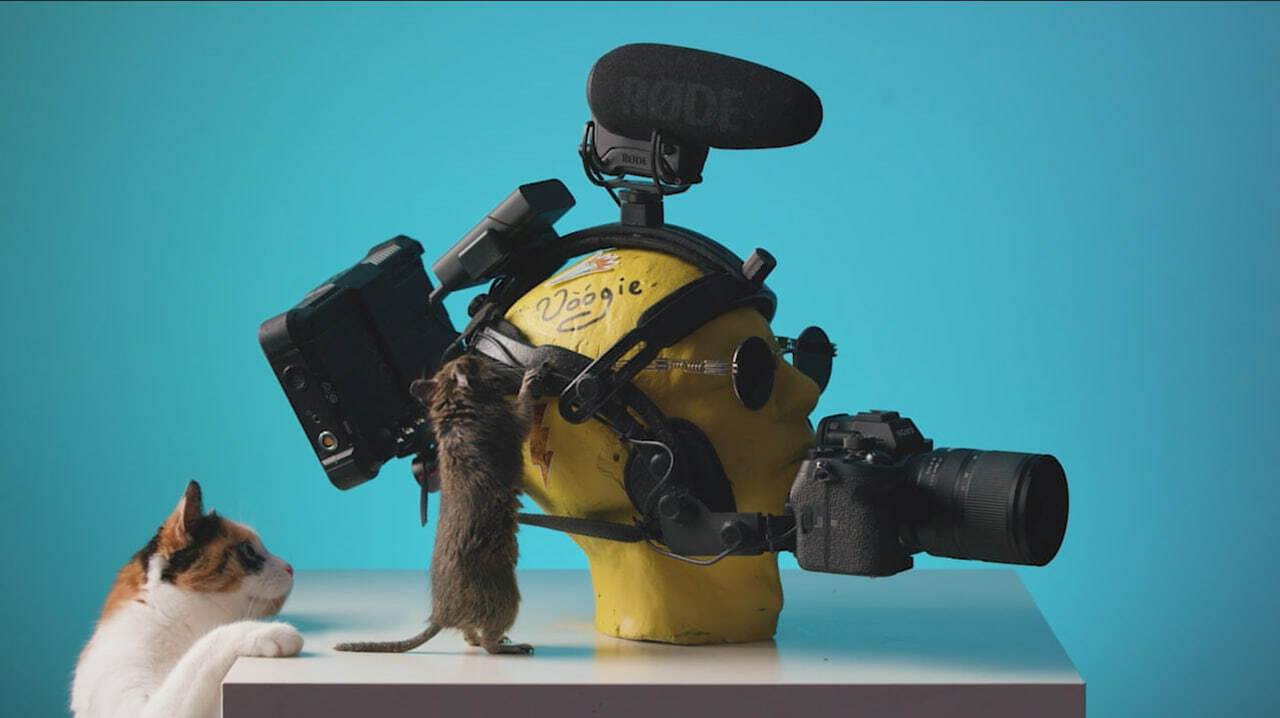
And that, my friends, brings us to the end of this saga. But, hey, if you – yes, you, the persistent soul who's made it this far through this epic read – happen to be a serial investor with a cool half a million dollars burning a hole in your pocket, eager to build a brand and propel this project forward, well, I'm all ears. Just drop me a line by whichever means you fancy, and we'll chat.
To everyone else, I extend a hearty thank you for sticking it out to the end of this tale. I hope it's been as riveting for you as it was for me to live it...
To everyone else, I extend a hearty thank you for sticking it out to the end of this tale. I hope it's been as riveting for you as it was for me to live it...
Stay tuned for the next chapter...
